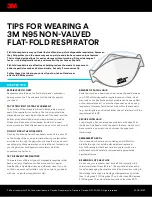
6
h)
Epilepsy (grand mal or petit mal)
i)
Pernicious anemia
j)
Diabetes (insipidus or mellitus)
k)
Breathing difficulties when wearing a supplied air respirator
l)
Claustrophobia or anxiety when wearing a supplied air respirator
m)
Abnormal EKG results from resting or stress tests
n)
Punctured or ruptured ear drum
o)
Medications
TRAINING PROGRAM
These brief written instructions cannot substitute for a formal Respirator Training Program. Such training must be taken prior to first
use of this product and should include an opportunity for you to handle the respirator, learn how to inspect it, have it properly fitted,
wear it in normal air for a long familiarity period, and finally, to wear it in a test atmosphere.
The Training Program should be based on the most recent OSHA Regulation 29 CFR Section 1910.134, CSA Standard Z94.4, or
Australian and New Zealand Standard 1715. You should also be familiar with any other pertinent regulations promulgated by various
Regulatory Authorities including ANSI Z88.2 in the USA.
FIT TESTING
Any respirator with a tight fitting facepiece may not be assigned until the user is given a qualitative or quantitative respirator fit test
and the results of the test indicate that the facepiece of the respirator fits that person properly. The 7600 Series is available in two
sizes. The letters “M/L” or “S” on oral/nasal cup indicate sizes Medium/Large or Small. See instructions below for putting on the
respirator. Refer to the most recent OSHA 29 CFR 1910.134 Appendix A (USA), CSA Z94 (Canada), or AS/NZS 1715 for specific
Fit Test procedures (Australia and New Zealand), or Brazilian MTE Respiratory Protection Program.
KEY TO NIOSH APPROVAL LABEL CAUTIONS AND LIMITATIONS FOR AIR-PURIFYING RESPIRATORS
A
Not for use in atmospheres containing less than 19.5 percent oxygen.
B
Not for use in atmospheres immediately dangerous to life or health.
C
Do not exceed maximum use concentrations established by regulatory standards.
H
Follow established cartridge and canister change schedules or observe ESLI to ensure that cartridges and canisters
are replaced before breakthrough occurs.
J
Failure to properly use and maintain this product could result in injury or death.
L
Follow the manufacturer’s User’s Instruction for changing cartridges, canisters and/or filters.
M
All approved respirators shall be selected, fitted, used and maintained in accordance with OSHA and other
applicable regulations.
N
Never substitute, modify, add or omit parts. Use only exact replacement parts in the configuration as specified by


































